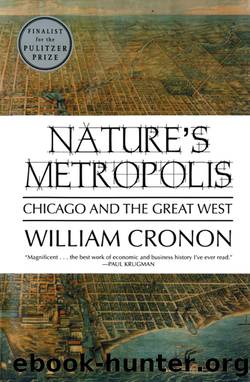Nature's Metropolis by William Cronon

Author:William Cronon
Language: eng
Format: epub
Publisher: W. W. Norton & Company
in the sense of being a primary market for the purchase and sale of agricultural products of the western and northwestern States and Territories, and for supplying general merchandise throughout this region, the range of the trade of Chicago embraces Illinois, Wisconsin, Northern Michigan, Iowa, Northern Missouri, Kansas, Nebraska, Colorado, the Territory of Dakota, the Indian Territory [Oklahoma], New Mexico, and the other Territories as far west as the eastern borders of the States of California and Oregon, an area constituting more than one-half of the territorial limits of the United States exclusive of Alaska.81
Chicago in no way had this territory to itself. Merchants from St. Louis, Milwaukee, Minneapolis, Kansas City, San Francisco, and the eastern port cities all contested it for the trade of western customers. But only New York competed so effectively over so wide an area. No other western city before or since has embraced such a large region as its gateway hinterland.
As the urban hierarchy west of Lake Michigan gradually filled out the system of central places, it in effect did so beneath Chicago. The city system of the Great West grew up in Chicago’s shadow, with consequences too numerous to trace. When Kansas City and Omaha emerged as regional meat-packing centers competing with Chicago in purchasing and slaughtering western livestock, they did so under the corporate control of Chicago firms. Chicago companies would organize shipments of fruit from California to New York. Chicago banks would finance and over-see investments throughout the West.82 But perhaps the most telling evidence of Chicago’s western shadow was nearer to home: the state of Iowa never developed a regional metropolis of its own. A resident of Clinton, Iowa, could report in 1876 that the state had “no market-town for her surplus products,” so that “the great bulk” went “to Chicago and to points farther east.”83 Chicago remains the chief metropolis of Iowa to this day. Just so did Chicago’s gateway and city system leave a permanent imprint on the western landscape.
And yet the reshaping of that landscape was subtler still. The distribution of high- and low-ranked urban places was only one expression of the new market system that Chicago helped impose on the region to its west. Cities and towns were the empty vessels within which farmers, workers, merchants, and manufacturers did their business, whether in grain elevators, packing plants, or retail stores. The geography of capital expressed itself not just as these physical structures but as the ways people lived, worked, and traded within them. It mattered that residents of Omaha had relegated their old St. Louis crates to basements, and that so many of the barrels and boxes heaped on the city’s sidewalks now had “Chicago” stenciled on their sides. To people in Omaha, those boxes were as much a part of the changing landscape as the system of cities that identified their town’s position on the map. Beyond the maps of rank-ordered central places, after all, beyond the abstractions of capital and credit, were the ordinary markets
Download
This site does not store any files on its server. We only index and link to content provided by other sites. Please contact the content providers to delete copyright contents if any and email us, we'll remove relevant links or contents immediately.
| Africa | Americas |
| Arctic & Antarctica | Asia |
| Australia & Oceania | Europe |
| Middle East | Russia |
| United States | World |
| Ancient Civilizations | Military |
| Historical Study & Educational Resources |
The Body: A Guide for Occupants by Bill Bryson(4974)
Liar's Poker by Michael Lewis(3368)
Into Thin Air by Jon Krakauer(3308)
Tuesdays With Morrie by Mitch Albom(2693)
Into the Wild by Jon Krakauer(2581)
The Diamond Cutter by Geshe Michael Roach(2017)
My Dark Places by James Ellroy(1880)
Columbine by Dave Cullen(1815)
Helter Skelter: The True Story of the Manson Murders by Vincent Bugliosi & Curt Gentry(1697)
Extraordinary, Ordinary People by Condoleezza Rice(1468)
Everything in Its Place by Oliver Sacks(1442)
Pilgrim at Tinker Creek by Annie Dillard(1390)
Into the wild by Jon Krakauer(1382)
You Can't Touch My Hair by Phoebe Robinson(1356)
The Girls: Sappho Goes to Hollywood by Diana McLellan(1281)
Dark Towers by David Enrich(1204)
Betrayal by Gregg Olsen(1201)
Call Sign Chaos by Jim Mattis & Bing West(1183)
The Letters of Allen Ginsberg by Allen Ginsberg(1113)
